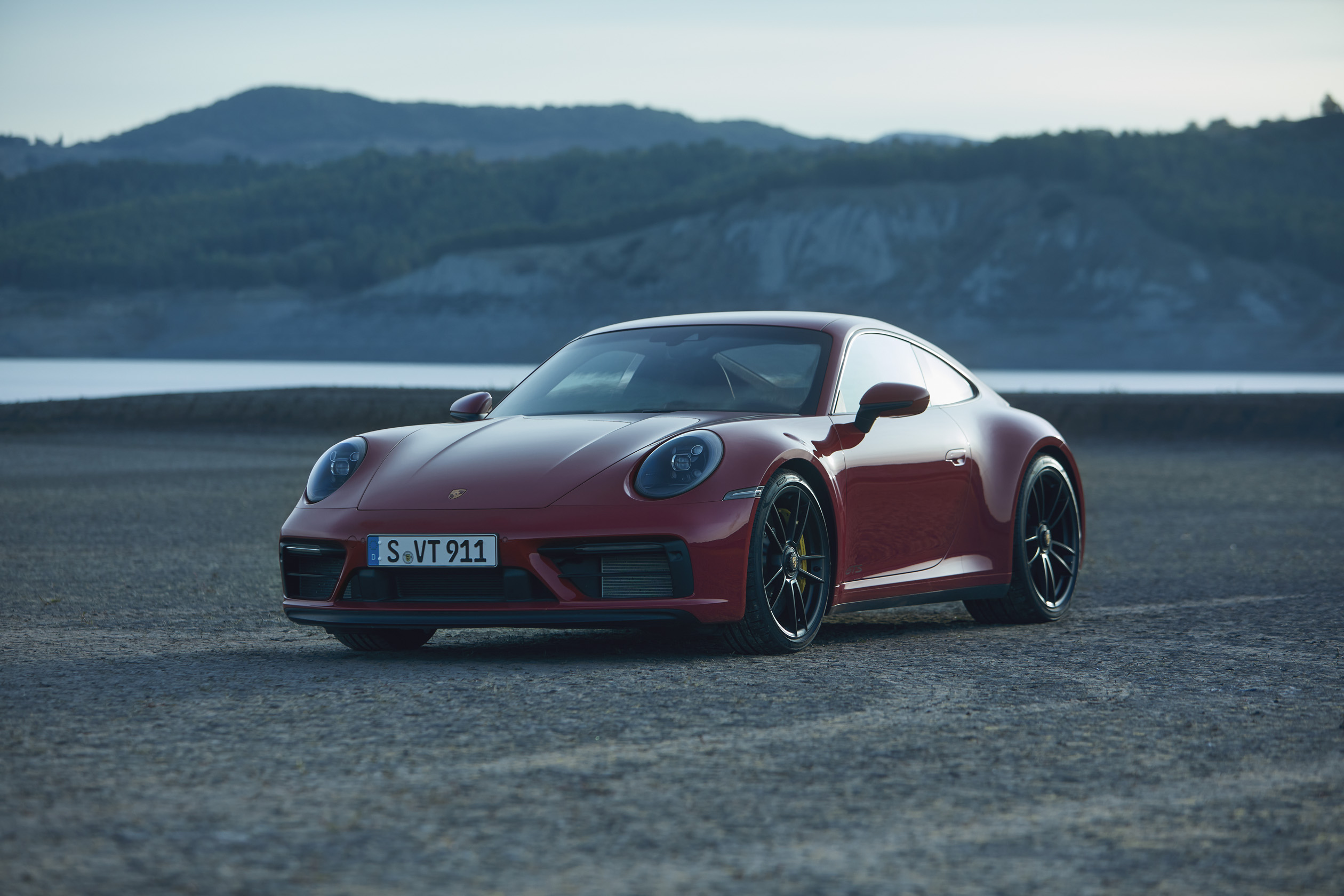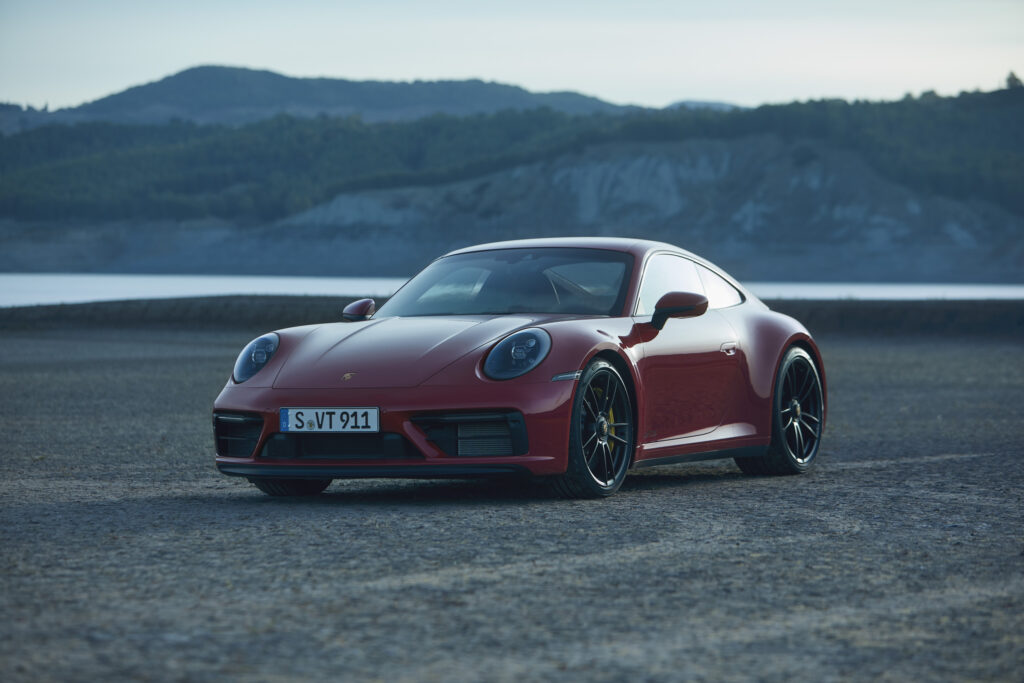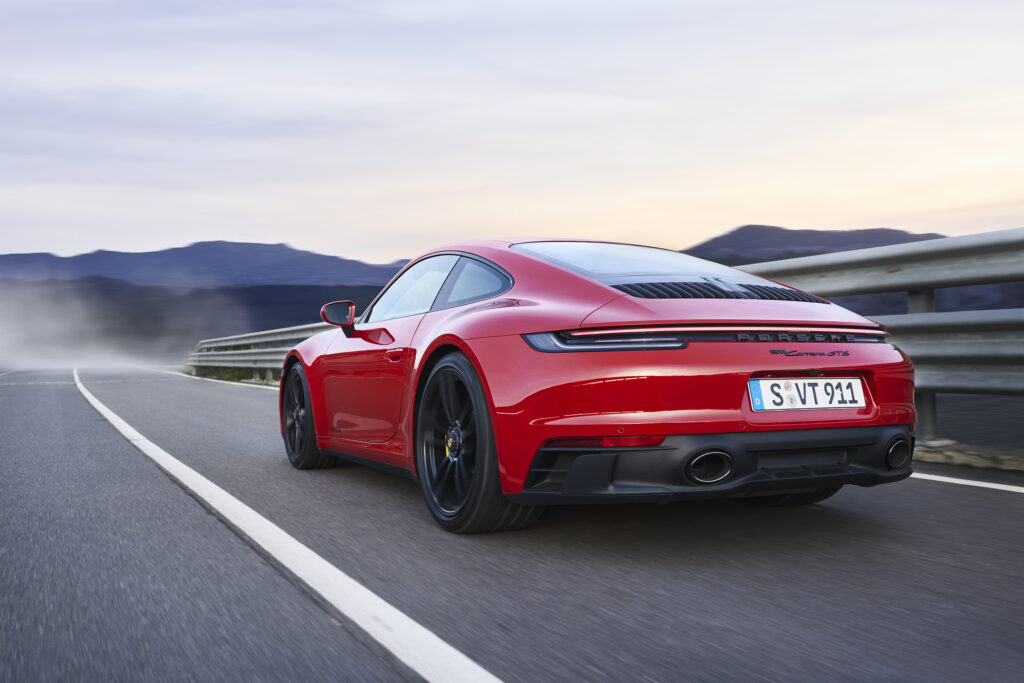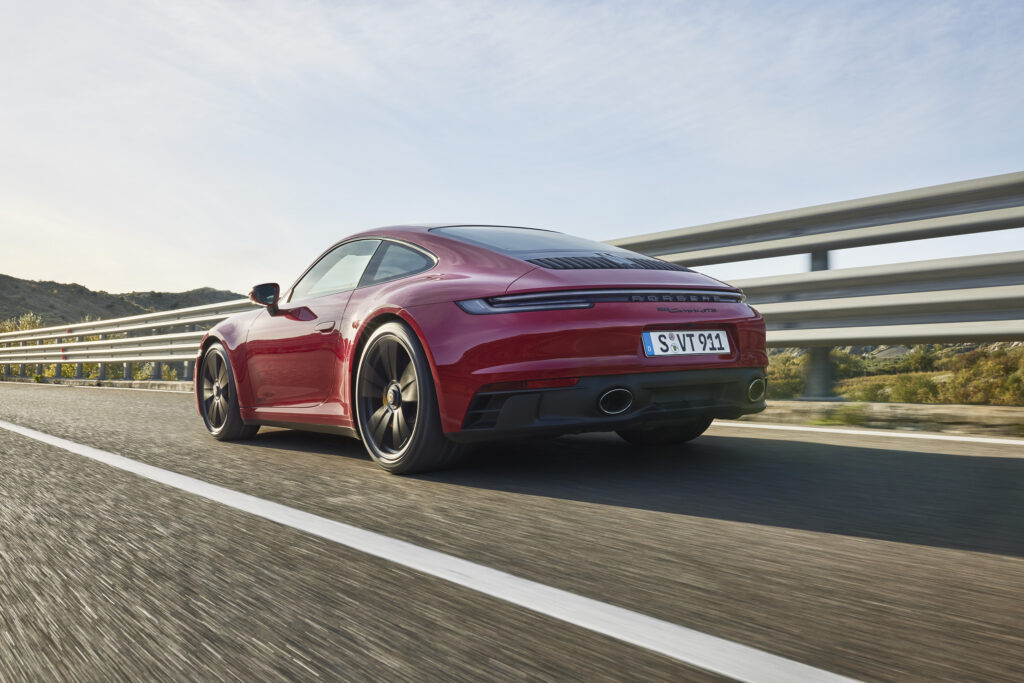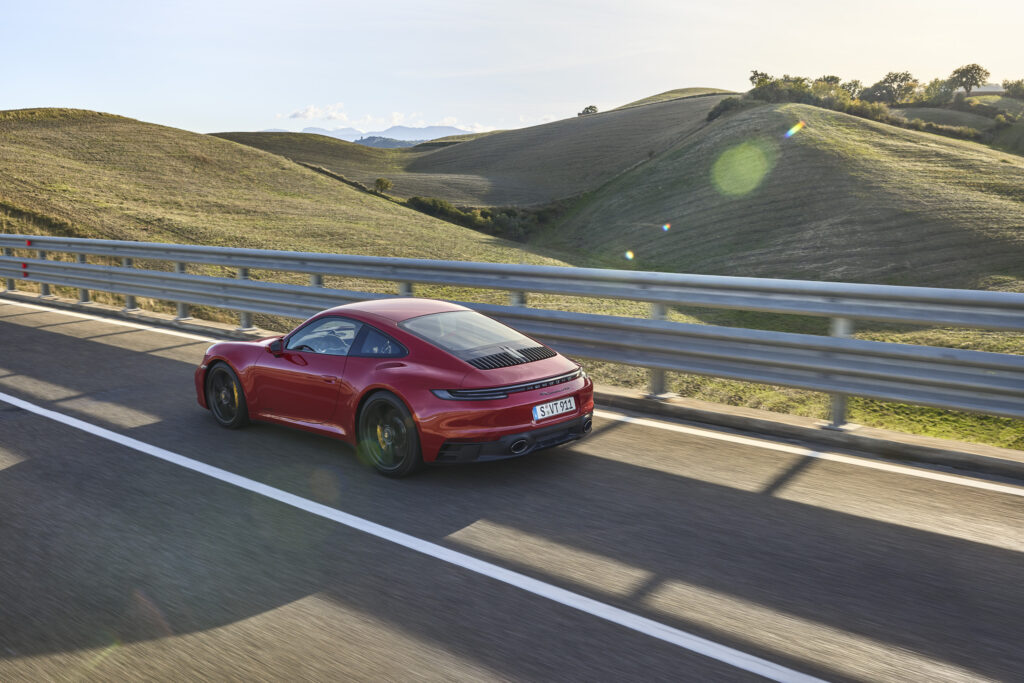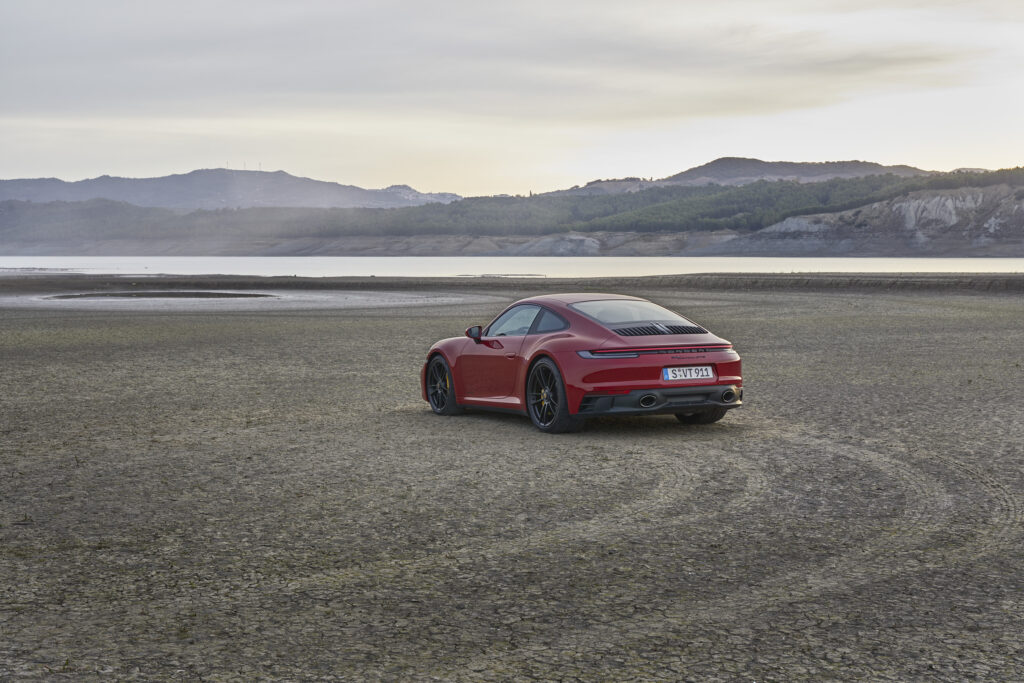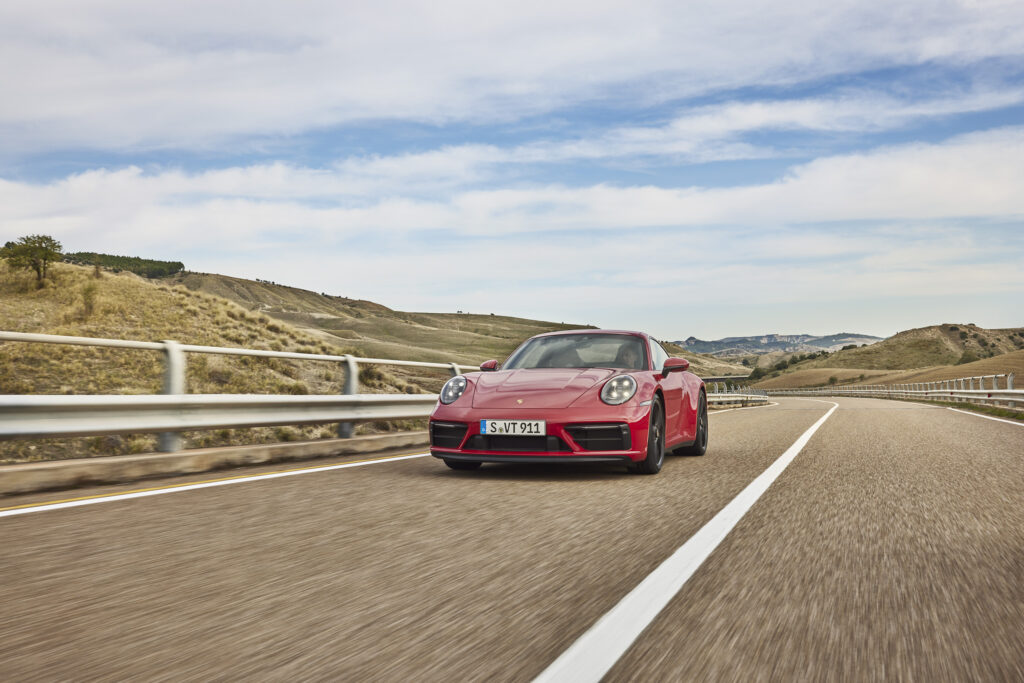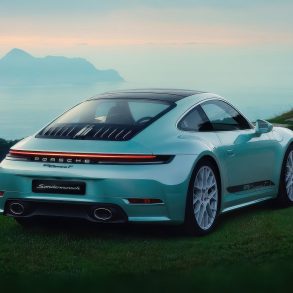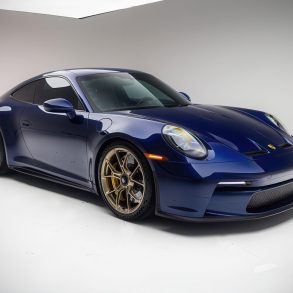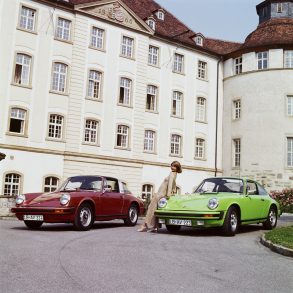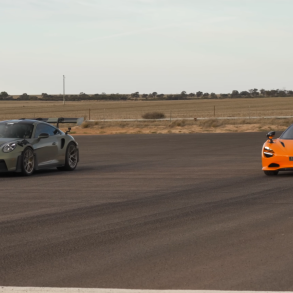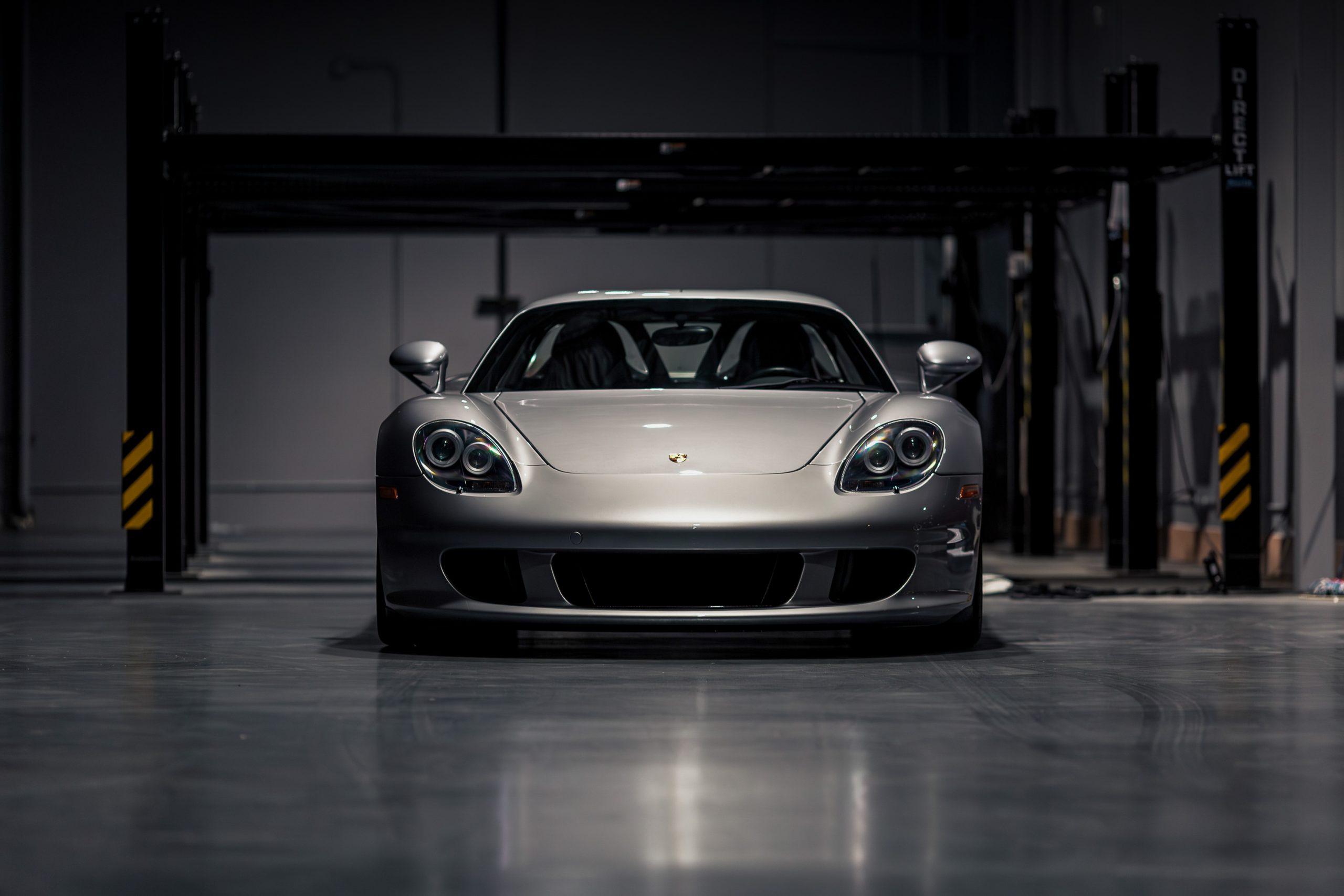2022 – 2024 Porsche 911 Carrera GTS (992.1) – Reviews, Pricing, Specs & Buyers Guide
The 992.1 Porsche 911 Carrera GTS is the modern “sweet spot” 911—hotter than a Carrera S, friendlier (and cheaper) than a GT3, and built from a curated set of upgrades that matter on real roads. Introduced for model year 2022 and sold through 2024, the first-gen 992 GTS ran the proven 3.0-liter twin-turbo flat-six at 473 hp and 420 lb-ft, paired to either a 7-speed manual or an 8-speed PDK, then layered in PASM Sport (-10 mm), Turbo-grade brakes, center-lock 20/21-inch wheels, a GTS-tuned sport exhaust, and meaningful weight-reduction options (the first-ever GTS Lightweight package). Think of it as the distilled essence of the non-GT 911.
Porsche announced the 992-series GTS family in June 2021, with U.S. deliveries starting early 2022. The headline figures set the tone: 473 hp (up 30 hp on the Carrera S) and 420 lb-ft, courtesy of higher boost pressure and calibration. With PDK, Porsche quoted 0–60 mph as quick as 3.1 s (for the AWD 4 GTS Coupe); manuals were offered across the GTS range for purists. Five body/drive combos launched, but this guide focuses on the rear-drive GTS Coupe.
The GTS brief was familiar but sharpened for 992: take useful bits from the Turbo and GT department, keep day-to-day usability, and deliver a car that feels special at any speed. That’s why the 992.1 package bundles a bespoke sport suspension derived from the Turbo, PASM Sport (-10 mm), helper springs at the rear, Turbo-spec brakes, center-lock wheels, and a GTS-specific exhaust and reduced insulation for more character—all standard on the GTS.
Powertrain, Chassis & Brakes
Engine & Transmissions
- 3.0-liter, twin-turbo flat-six (VTG)
- 473 hp, 420 lb-ft (U.S. ratings)
- 8-speed PDK dual-clutch or 7-speed manual (short-throw lever, –10 mm)
Suspension & Aero
- PASM Sport with –10 mm ride height and model-specific tuning; helper springs at the rear keep the main springs under tension for consistent rebound behavior.
- Sport Design exterior package elements and dark-tinted lighting, standard on GTS.
Wheels & Tires
-
Center-lock wheels: 20-inch front / 21-inch rear, design derived from Turbo S (five-lug wheels available as a no-cost alternative).
Brakes
-
Turbo-grade iron brakes (six-piston front / four-piston rear); PCCB ceramics optional.
Performance: Claims vs. Reality
Factory acceleration varies by drivetrain and gearbox, but Porsche quoted as low as 3.1 s to 60 mph for the 4 GTS PDK; the rear-drive Coupe sits just behind on paper. In independent testing, Car and Driver ran a 2022 911 GTS (PDK) to 60 mph in 2.8 seconds, and their manual GTS still stormed the quarter in 11.3 s @ 126 mph, among the quickest manual cars they’ve ever timed. That gap between brochure and reality is classic Porsche.
For international context, Porsche’s global spec page lists the GTS 0–100 km/h at 3.0 s with Sport Chrono and a top speed around 312 km/h (194 mph)—again lining up with the U.S. testing that shows the car is seriously fast regardless of transmission.
What you feel from the driver’s seat is the bandwidth. The small turbos and short gearing keep the flat-six right in the meat of its torque; PDK makes every launch clinical, while the manual brings old-school satisfaction with very little speed penalty once rolling. The PASM Sport chassis rides firmer than a Carrera S but tracks cleanly over broken tarmac; add rear-axle steering and the car shrinks around you in tight bends while staying planted in fast sweepers.
The Lightweight Package (why it matters)
Available for the first time on a GTS, the Lightweight Package removes up to ~55 lb (≈25 kg) via CFRP full bucket seats, lightweight glass, a lightweight battery, and a rear-seat delete. The package also bundles rear-axle steering and additional aerodynamic underbody panels. In practice it’s less about lap times and more about feel: louder, tighter, and just a bit more raw—without wrecking ride quality. Reviewers consistently note the spec transforms the car’s character.
Interior & Tech
GTS cabins lean black Race-Tex (seats, wheel rim, door pulls) with optional GTS Interior Package contrast stitching. Sport Seats Plus are standard; CFRP buckets come with the Lightweight Pack. Crucially, the 992 platform’s PCM 6.0 infotainment gained a January 24, 2022 update that improved UI/voice and brought Android Auto support to the 911—if seamless phone integration matters, MY2022+ cars with the updated PCM are the easy button.
How It Drives
The 992.1 Carrera GTS is defined by effortless speed and clarity of feedback. Compared with a Carrera S, the extra boost and shorter gearing make the car lunge harder from low rpm. The GTS-tuned exhaust and reduced insulation feed more sound into the cabin without the drone that plagues some aftermarket systems. The Turbo-derived brakes are stout and confidence-inspiring, with PCCB available if you value fade resistance on mountain descents or track work. And despite the firmer PASM Sport setup, the GTS still works as a daily—firm, yes, but not punishing on decent pavement. MotorTrend called 3.0-second 0–60 runs “on the table” and praised the suspension’s duality.
Opting for the manual adds engagement and a lighter, more talkative front end under trail-braking. Car and Driver logged that 11.3-sec quarter-mile for the manual and loved the old-school feel, while noting the ride can be brutally stiff on poor surfaces—worth remembering if your roads are rough and you’re eyeing the Lightweight spec.
Detailed Specifications (Highlights)
- Engine: 3.0-liter twin-turbo flat-six (VTG) — 473 hp / 420 lb-ft
- Transmissions: 7-speed manual (short throw) or 8-speed PDK
- Drivetrain: RWD (Carrera 4 GTS available separately)
- Chassis: PASM Sport (–10 mm) with helper springs; rear-axle steering optional (standard with Lightweight Pack)
- Brakes: Turbo-spec iron brakes; PCCB optional
- Wheels/Tires: 20/21-in center-lock (five-lug available at no cost)
- Exhaust: GTS-specific sport exhaust, less interior insulation
- Performance (typical): 0–60 mph 2.8–3.2 s depending on spec/gearbox; ~194 mph top speed (manufacturer/global figures)
Model-Year Updates
- 2022 (launch year): 992.1 GTS arrives with 473 hp, PASM Sport (–10 mm), Turbo-spec brakes, center-lock 20/21s, GTS sport exhaust, Sport Chrono (with tire temperature display and mode switch) and Race-Tex cabin. Lightweight Package debuts (CFRP buckets, lightweight glass, battery, rear-seat delete, RAS, extra aero), saving up to 55 lb. PCM 6.0 receives a January 24, 2022 update with Android Auto and UI improvements.
- 2023: Running changes and option reshuffles (wheels, upholstery, assistance packages) with no core mechanical updates to the 992.1 GTS recipe.
- 2024 (final 992.1 year): Continuation of the package ahead of the 992.2 refresh. For context only, the 2025 GTS switches to T-Hybrid (532 hp), which cemented 2022–2024 as the last pure-ICE GTS generation.
Reception & Reviews (What the Press Said)
- Car and Driver (PDK, Jan 2022): 2.8 s to 60 mph and emphatic praise for the curated GTS upgrades (suspension, mounts, brakes, exhaust) that make it meaningfully sharper than a Carrera S.
- Car and Driver (Manual, Jul 2022): Manual GTS 11.3 s @ 126 mph in the quarter; called one of the quickest manuals they’ve tested, with the caveat of a very stiff ride when so equipped.
- MotorTrend (First Drive, Sept 2021): Reaffirmed Porsche’s conservative claims and said “3.0 seconds is probably on the table.” Praised composure and breadth of ability.
- Road & Track (Sept 2021): Labeled a well-specced GTS (manual + Lightweight + PCCB + center-locks + RAS) one of the most “911-y” feeling modern 911s—the sweet spot between GT refinement and GT-department intensity. Consensus: the 992.1 GTS isn’t just a trim; it’s a purposeful recipe that delivers near-GT3 involvement with everyday civility and Turbo-level confidence.
Options & Packages That Matter
- Lightweight Package: If you want more edge (and don’t need back seats), the ~55-lb reduction plus bundled rear-axle steering meaningfully sharpen responses and increase cabin drama. Daily-driver comfort is still acceptable on good roads.
- PCCB (ceramic brakes): Outstanding fade resistance and pedal consistency; costly to replace if damaged, but very durable in street use.
- Rear-Axle Steering (stand-alone if not LW Pack): Makes the car feel smaller at low speed, calmer at high speed—worth it for tight city or mountain driving.
- Five-lug wheels (no-cost): If you don’t want center-lock wheels for track tire changes or peace of mind, Porsche offers conventional wheels at $0. You keep the look/sizes, lose the single-nut hub.
- Manual vs PDK: PDK is quicker and effortless; manual adds character and is still ferocious by any sane yardstick. C/D’s data makes both cases compelling.
Buying Guide (Used)
- Spec audit: Verify Lightweight Pack content (CFRP buckets, rear-seat delete, lightweight glass/battery, RAS) on the build sheet; don’t assume from photos.
- Wheels & tires: Inspect center-locks for proper torque/service history; if five-lug, confirm the option. Check inner shoulders on the 21-inch rears for accelerated wear.
- Brakes: Turbo-grade irons are robust; PCCB rotors last a long time on the road but are pricey—inspect faces for chips.
- Ride & NVH expectations: Lightweight glass, less insulation, and the PASM Sport tune make some builds notably firmer/noisier; align expectations with your roads (the C/D manual test is a good reality check).
- Infotainment: If Android Auto matters, confirm PCM 6.0 with the Jan 24, 2022 update on early 2022 cars.
- Provenance: The 992 platform is robust; prioritize clean service records, correct tires (N-spec/matched), and a stock ECU if warranty is in play.
Ownership Experience & Verdict
Live with a 992.1 GTS and it feels…easy. Visibility is excellent, the cabin is ergonomically clean, and PASM Normal calms the ride for commuting. Ask for everything and it obliges with repeatable shove, superb brake feel, and a chassis that communicates without punishing. The GTS exhaust and pared-back insulation deliver more 911 soundtrack without long-haul drone, and rear-axle steering expands its envelope on both tight urban grids and high-speed sweepers. As Road & Track put it, in the right spec the GTS is one of the most authentic-feeling modern 911s.
The 992.1 911 Carrera GTS Coupe is the 911 for people who want more of everything that counts—speed, steering feel, brake confidence, noise—without sacrificing daily civility. If you live on smooth, fast roads, target Lightweight Pack + rear-axle steering; add PCCB if you cook brakes or live in the mountains. If you’re city-bound or road-trip often, stick with Sport Seats Plus, consider five-lug wheels, and let PDK do what it does best. Either way, you’re getting the sweet-spot 911 of the 992.1 era.
In 2025, Porsche introduced the 992.2 Carrera GTS with a T-Hybrid system (532 hp), dropping headline acceleration even further (as quick as 2.5 s to 60 mph in independent testing). That shift also cements the 2022–2024 GTS as the last pure-ICE Carrera GTS—a detail that matters to some buyers and collectors.
What We Said At Launch
The Carrera GTS has occupied a sweet spot in the Porsche 911 range for a while now. The GTS first turned up a decade ago to plug the gap between the Carrera S and Turbo. And at the time, when regular 911s were naturally aspirated and Turbos were blown, that was a gap, but the GTS wasn’t the perfect stopper. It was an uprated Carrera S and that was about it. The simplest way to think of it is to take a Carrera S, give it a bit more power, add the performance options enthusiasts want, spec different exterior and interior trim, and sell it for less than the cost of adding all those options to a Carrera S.
The reality was that you could basically build your own GTS. In the past, Porsche offered an optional factory “power kit” for 911 Carreras, but things are different now. That isn’t an option for the 992. The 992 Porsche 911 Carrera GTS is therefore your only pass for accessing a version of the 3.0-liter twin-turbo flat-six tuned up to 473 hp and 420 ft lbs of torque. Those figures are achieved via an approximately 14.5 percent increase in turbo boost pressure (the peak is now 18.3 psi), and they reflect improvements of 30 hp and 30 ft lbs compared to the 992 Carrera S. The only actual engine-hardware upgrade, Porsche says, is a strengthened dual-mass flywheel to cope with the additional torque.
While the 911 Carrera GTS gets the same 3.0-liter twin-turbo flat-six as the current Carrera S, massaging it to 473 hp and 420 lb-ft of torque means it has 30 hp more than the previous 911 Carrera GTS and the current Carrera S, which is meaningful. With the eight-speed PDK dual-clutch automatic, the 911 Carrera GTS can sprint to 60 mph in 3.2 seconds. A seven-speed manual will remain on offer and features a shifter that’s been shortened by 10 mm. Every 911 Carrera GTS also gets a sport exhaust system as standard.
In addition to more power, the 911 Carrera GTS has a specially tuned version of Porsche’s Active Suspension Management that’s lower than the standard setup by 10 mm. Helper springs in the rear maintain tension on the main springs to keep rebound characteristics consistent. The PASM adaptive dampers comes from the 911 Turbo but with revised calibration to its active damping, and it carries different spring rates. Compared to a Carrera S, for example, the GTS’ rear springs are approximately 18 percent stiffer, and the fronts are nearly 50 percent stiffer. The rear end also gets stability- and response-aiding helper springs–they keep the main springs firmly in their perches when the suspension is unloaded.
The brakes are upgraded, too, as the Carrera GTS receives the Turbo’s six-piston front-caliper/four-piston rear setup, and carbon-ceramics are available. Rear-wheel steering is also among the optional extras. The car rides on lighter 911 Turbo S center-lock wheels measuring 20 inches up front and 21 inches at the rear, although the fronts are half an inch narrower than the Turbo S’. If you don’t like the idea of dealing with center-lock rims, Porsche offers five-lug designs as no-cost alternatives.
Motortrend: As with the previous 991.2 GTS, the car makes a strong case as the best 911 for enthusiastic driving that doesn’t require full-bore GT3 levels of track-ready hardware and big aerodynamic downforce.
The seven-speed works through a mechanically locking differential; PDK cars use an electronic-locking diff and Porsche Torque Vectoring Plus. A shift knob shortened by 0.4 inch is a difference compared to other manual 911s, but most important is the fact you can now defeat auto rev-matching during downshifts in any of the car’s drive mode settings.
There is also a new Lightweight package which cuts 55 pounds from the car’s curb weight. It does this with lightweight glass for the side and rear windows, carbon-fiber bucket seats, a lightweight battery, rear-wheel steering, additional underbody panels, and the deletion of the rear seats.
Distinguishing the 911 Carrera GTS is black contrasting exterior bodywork and darkened headlight clusters. On Targa models, the silver Targa bar is replaced by a black one. Race-Tex cloth upholstery is standard. Black wheel locks, 20-inch front, and 21-inch rear black alloy wheels, a black front lip spoiler, and a black engine cover grille are also standard on the GTS models. Every 911 Carrera GTS also gets the SportDesign package, which adds darkened taillights and black badges.
Motortrend: The driving experience is like that of the Carrera S—but way more of it. Front-end bite and response was one of the 992’s notably impressive characteristics when it launched, and it’s even more apparent on the new GTS.
Inside, the 911 Carrera GTS’ interior gets the Race-Tex cloth upholstery standard, which is also used on the steering wheel, door handles, armrests, and gear selector. The GT sport steering wheel, Sport Chrono package, Porsche Track Precision app, and tire temperature display are also standard equipment. All GTS models get the Sport Seats Plus with four-way power adjustment. The latest version of Porsche’s PCM interface gets Apple CarPlay and Android Auto compatibility; however, the latter requires plugging into a USB port. It also features a new virtual assistant function that you activate by saying “Hey, Porsche.”
The 2022 Porsche 911 Carrera GTS goes on sale in early 2022 with a standard price of $138,050 for the rear-drive coupe and $150,850 for the rear-drive convertible. Adding AWD will cost you an extra $7,300 for the coupe and convertible variants. The most expensive version is the 911 Targa 4 GTS—- which gets AWD standard and costs $158,150 — the same as an AWD-equipped convertible.
The formula yields an excellent soundtrack, satisfying power, and stunning handling that hoovers painted lines off your favorite challenging road. It’s a car with no discernible real-world weakness, and it will do a hell of a job during your track-day runs, as well.
Videos & Reviews
Official Launch Video
Pictures
Press Release
June 22, 2021
More distinctive and dynamic than ever: the new 2022 Porsche 911 GTS models
Five model variants are being added to the successful 911 range
Atlanta. Twelve years ago, the very first GTS version of the 911 was introduced – featuring a series of very targeted modifications that, when brought together combined to make a difference – as a more focused, more dynamic and faster 911 that retained the subtly and usability of the car on which it was based. Following a familiar theme, a new generation of the popular sports car model is being launched. More powerful and visually distinctive, and with better driving dynamics than ever, the six-cylinder boxer engine at the heart of the 911 GTS delivers 473 hp, which is 30 hp more than the current 911 Carrera S and 23 hp over the previous 911 GTS. Torque rises to 420 lb-ft.
The result of this extra potency is a zero to 60 mph sprint of just 3.1 seconds in the case of the 911 Carrera 4 GTS coupe equipped with the eight-speed Porsche dual-clutch transmission (PDK): three tenths faster than its predecessor. A seven-speed manual transmission with a gear lever shortened by 10 millimeters is available for all 911 GTS models as an alternative to the PDK.
The 911 GTS is available in five variants:
- 911 Carrera GTS with rear-wheel drive, as Coupe and Cabriolet
- 911 Carrera 4 GTS with all-wheel drive, as Coupe and Cabriolet
- 911 Targa 4 GTS with all-wheel drive
Joining the increase in power is GTS-specific suspension tuning with Porsche Active Suspension Management (PASM), and the high-performance braking system from the 911 Turbo. Driving dynamics can improve even more through the optional Lightweight package, which will be available on the 911 Carrera GTS coupe models for the first time, saving up to 55 lbs. in weight. Setting the 911 GTS apart is black contrasting bodywork elements and darkened headlight housings. Inside, the interior features many of the touchpoints finished in grippy Race-Tex cloth material. The latest generation of Porsche Communication Management (PCM) brings numerous improvements in operation and connectivity. Technology: bespoke suspension and unique Sport Exhaust system Derived from the 911 Turbo and modified for the GTS coupe and Cabriolet models, the suspension meets exacting performance demands – with Porsche Active Suspension Management (PASM) Sport suspension that lowers the ride height by 10 millimeters featuring as standard equipment. The suspension includes helper springs at the rear to help maintain tension on the main springs in all driving conditions, meaning rebound characteristics are consistent. As in the previous generation, the 911 Targa GTS is an exception, sharing its chassis with the 911 Targa 4S.
The engineers in Weissach have also adjusted stopping performance to match the increased performance of the GTS, which makes use of the high-performance braking system from the 911 Turbo. The 20-inch (front) and 21-inch (rear) black, center-lock alloy wheels have a design derived from the 911 Turbo S. The standard Sport exhaust system is responsible for an even more emotive soundtrack, thanks to its GTS-specific set-up and a reduction in sound deadening material.
Exterior: numerous black accents in satin or high gloss
A multitude of black or darkened exterior details are characteristic of the 911 GTS models. On the 911 Targa 4 GTS, this also includes the model-defining Targa bar and Targa lettering. Additional elements painted in Satin Black include the spoiler lip, the center-lock alloy wheels, the engine cover grille, and the GTS script on the doors and rear of the car. The exterior package, in which these and other details are executed in high-gloss black is optionally available. All 911 GTS models effectively have the SportDesign package, with distinctive trim for the front, rear and the side sills. The headlight trims and daytime running light surrounds are darkened, and the car is fitted with standard LED headlights with Porsche Dynamic Light System Plus (PDLS Plus). The rear lights are also darkened. Satin Black accents characterize the model designation, PORSCHE lettering and charge-air grille slats above the engine.
Lightweight package: less weight
Driving dynamics are further improved with the Lightweight package, which will be available for the first time on a GTS. Up to 55 lbs. can be saved by the lighter carbon fiber full bucket seats, lightweight glass for the side and rear windows, and the use of a lightweight battery. The rear seats are also removed. Other performance enhancements include rear-axle steering as part of this equipment package and additional aerodynamic underbody paneling.
Interior: black Race-Tex and standard Sport Seats Plus
The sporty details of the GTS models continue inside functionally as well as visually. The gear lever of the optional seven-speed manual transmission has been shortened by 10 mm, which enables fast gear shifts with a flick of the wrist. A GT Sport steering wheel as well as the Sport Chrono package with mode switch, Porsche Track Precision app and a tire temperature display are standard features. The standard Sport Seats Plus with electric four-way adjustment provide lateral support, comfort and convenience. The interior insulation has been reduced.
Numerous Race-Tex features underscore the elegant dynamic ambience. The seat centers, the steering wheel rim, door handles and armrests, storage compartment lid and gear lever are all trimmed in Race-Tex. With the optional GTS interior package, the stitching is available in Carmine Red or Chalk. The seatbelts and embroidered GTS lettering on the headrests, tachometer and Sport Chrono clock come in the same contrasting colors. Carbon fiber interior trim panels complete the package.
New display and operating concept: now also with Android Auto
The new generation of the Porsche Communication Management (PCM) features additional functions and significantly simplified operation. The touch icons in the Media menu have been enlarged and the option of rearranging the tiles on the home screen is new. The improved voice assistant recognizes natural speech and can be activated with “Hey Porsche.” iOS and Android users will enjoy standard Wireless Apple CarPlay® and now wired Android Auto™.
First deliveries for the US are expected in early 2022 with a starting MSRP of $136,700 excluding $1,350 for delivery, processing, and handling.
- 911 Carrera GTS $136,700
- 911 Carrera GTS Cabriolet $149,500
- 911 Carrera 4 GTS $144,000
- 911 Carrera 4 GTS Cabriolet $156,800
- 911 Targa 4 GTS $156,800


